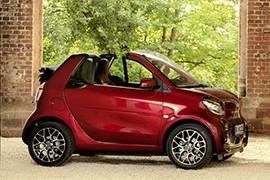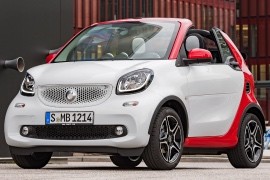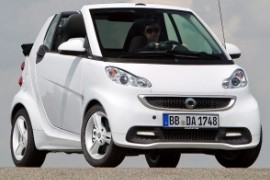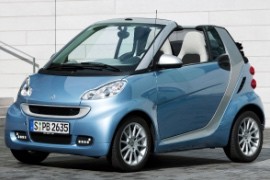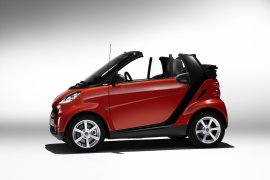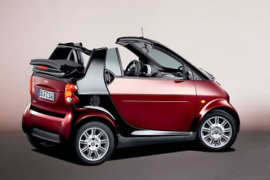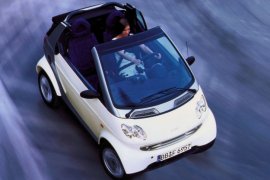SMART fortwo Cabrio Models/Series Timeline, Specifications & Photos
First production year: 2000
Engines: Electric, Gasoline, Diesel
Body style: Convertible (spider/spyder, cabrio/cabriolet, drop/open/soft top)
Smart introduced a new electron-powered version of its well-known Fortwo product in 2019 and offered it in coupe and convertible shapes.
The smart brand was born after a short marriage between the German giant Mercedes-Benz and the Swiss watchmaker Swatch. Right from the start, the idea was to develop an electric-only small-sized vehicle fit for cities. After a while, the German automaker said that it couldn’t be done and their partners should reconsider their position and accept, at least for a while, fuel-efficient tiny vehicles fueled by gasoline or diesel. After many negotiations, the marriage was dissolved in 1998, even before the first product could reach the market. Two decades later, in 2008, Mercedes-Benz produced in a limited edition an electric version of the tiny vehicle, and after that, the EV era began. But Swatch was no longer onboard.
The 2019 model came with a new look and a daring proposal for the market. Instead of trying to be a jack-of-all-trades, it was just a city vehicle fit for two with a range that should be enough for the daily commute. It was stylish and could charge in about eight hours at a regular home outlet. Its front fascia featured organic-shaped headlights swept back on the sides and included LED daytime running lights. Moreover, the lower bumper featured a chicken-wire-style pattern for the grille and was flanked by a pair of round fog lamps. There was also a set of side scoops, but their main purpose was to look good. From its profile, the open-top smart featured a tilted windshield extended almost above the front seats. At the back, the wide B-pillar also served as a safety measure protecting the car’s occupants in the event of a roll-over accident. Behind it, the automaker offered customers to fold down the rear side of the roof, while the top panel could’ve been concealed under the trunk’s floor.
The cabin was refreshed compared to the 2016 model and featured tall seatbacks with integrated headrests. Fronting the driver was a classic smart instrument cluster with a TFT display surrounded by an analog dial for the speedometer. Mercedes-Benz added a new infotainment unit on the center stack, supporting Bluetooth connectivity. The standard version came well-equipped and included AC and heated seats. Underneath it, on the center console, the automaker placed the gear selector, two cup holders, and a tiny drawer on the side for some coins or headphones. Behind the tiny cabin was a briefcase-sized trunk placed above the rear axle and the electric motor.
A 60 kW (80 HP) motor powered this tiny vehicle for up to 159 kilometers (99 miles) on a single charge in ideal conditions. The car boasted a 4.8-second acceleration time from zero to 60 kph (45 MPH) and a top speed of 130 kph (81 MPH). Still, it was designed as a city vehicle and mostly for driving with the top down, so not in winter conditions too much.
The smallest car built by Mercedes Benz was the SMART ForTwo and beside the coupe version, it was also offered as a cabriolet. A mini-cabriolet for the urban roads.
SMART didn't have any competitor on the market for a long period of time. Its minimalist design and lilliputian dimensions made the car fit for the most crowded cities in Europe. It was shorter than the width of a bus and it could turn on a dime due to its rear-wheel-drive concept. The convertible version was launched at the 2015 Frankfurt Motor Show but the customers had to wait a few months before first deliveries. But who needed an open-top mini city-vehicle in the winter, anyway?
The 2016 SMART cabriolet was easy to recognize due to its honeycomb grille design and its hexagonal headlights. The short front fascia didn't feature a trunk compartment. It was just a panel between the front bumper and the windshield. The A-pillars were not very raked as in a usual two-door vehicle, but more straight up as found on an MPV. The B-pillars were slimmer than on the closed version. The styling of the Tridion safety cell was more progressive, giving the smart ForTwo cabriolet an even sportier and more forward-focused look.
The car could have been opened from outside the car due to its three-button keyfob. In just 12 seconds, the soft-top roof could have been opened and stored behind the B-pillars. From inside the car, the same operation could have been performed via a dedicated button on the center console.
One of the smallest cars on the market, the Smart Fortwo was redesigned for 2012, with a more catchy exterior and an overall better interior.
Designed as a small city car, the Smart Fortwo did the job. It was easy to park and manoeuvre around town in congested metropolitan environment.
While the small car looked tiny from the outside, the passengers inside would have plenty of room.
The fuel consumption was also good and the Smart Fortwo offered decent safety features.
Otherwise, the small 2-seater did not offer much comfort, agility or luxury and wasn’t the cheapest on the market.
The Smart Fortwo was offered in 2 body shapes, a hatchback coupe or a cabriolet. Both of them were available with two trim levels: Pure and Passion.
The Pure version included 15-inch steel wheels, keyless entry and a leather-wrapped steering wheel. The air conditioning was not standard and was available as an optional features, as well as a radio with an AUX and USB jack.
The Passion trim level included the Pure’s features and added 15-inch alloys wheels, a glass sunroof, heater power mirrors and a sport steering wheel.
The Cabriolet was equipped with a power convertible top, a glass rear window and side airbags.
An extensive list of features was available as optional.
The Smart Fortwo was equipped with a rear-mounted 1.2-liter 3-cylinder engine with 70 hp.
The automatomated manual transmission with a single-clutch was not the softest though.
SMART introduced a facelifted version for the ForTwo cabriolet in 2010 and enhanced the vehicle in all areas, starting with the exterior look and ending with the revised engines.
While it had a troublesome start, the SMART project was pushed forward by Mercedes-Benz even when it was losing money on every car sold. Slowly, the smallest car on the market managed to survive and became a fashion item, especially in the open-top version.
The facelifted version received a modified front fascia, with an option for LED daytime running lights in the lower apron. SMART offered the car in seven body colors, one more than on the previous model, and included a mat-finish look. Like in the 2007 model, the owner could have removed the door beams' upper side to uncover the vehicle completely. The carmaker added a choice for three 15" light-alloy wheels for the range.
Inside, SMART installed a full-fabric covered instrument panel with the new styling. The carmaker also introduced a new display at the bottom of the wide speedometer. For the infotainment system, the ForTwo received a 6.5" touch-screen on the center stack with navigation, fitted as an option. But even the base model received USB and AUX-in ports.
Under the hood, SMART upgraded the engines to increase the fuel-efficiency. Apart from the diesel version, which provided minimal CO2 emissions, the carmaker introduced the mild-hybrid gasoline units.
After the joint venture between Mercedes-Benz and Swatch ended, the German carmaker tried to keep the Smart brand alive and introduced the second generation of this micro-car in 2007.
Smart was already famous in Europe, and its customers loved it because it could be parked everywhere due to its very small size. Just like its predecessor, the smart ForTwo's second generation was also available with an open-top version.
Slightly longer than its predecessor, the 2007 ForTwo was good for transporting two occupants inside. At the front, it featured boomerang-shaped headlights above the smiling grille. The open-top version sported a set of beams above the doors that could have been removed for a complete open-top experience. Fortunately, the trunk was big enough to host them while roaming the city with the roof folded behind the seats.
Inside, the two occupants enjoyed a roomy area. Its high seating position and the big glass area around the cabin reduced any claustrophobic sensation. Moreover, with the canvas top folded in the back, the occupants had an even better experience. However, in case of rain, it took more time to cover it due to the removable bars above the doors. That's why most customers didn't do that unless there were zero rain chances. The new instrument cluster featured a wide speedometer in front of the driver with an LCD screen at the bottom. On the top middle of the dash panel, SMART offered an option for a tachometer and a clock.
Under the trunk's floor, SMART offered a choice of gasoline or diesel engines and an MHD (micro-hybrid-drive) system that included a belt-driven starter-generator. This system helped the car increase its fuel efficiency.
The smallest convertible ever produced by Mercedes-Benz was the SMART ForTwo Cabrio. It was introduced in 1998 and refreshed in 2004. It had cookies!
Mercedes-Benz and the Swiss watchmaker Swatch joined their forces to produce a vehicle suitable for crowded cities. The result was the 1998 SMART. After the launch, SMART bailed out, and the German carmaker had to buy the shares. Now, it had a new brand, and it had to manage it. Despite its losses, SMART had to change, and in 2004 it received a vital facelift, along with new Euro 4 engines.
The designers couldn't do too much for a shorter car on the exterior than most people's bathrooms. There was a new pair of headlights with a shape like a tilted and skewed 8 number at the front. In the rear, the B-shaped taillights were different than those used for the hard-top version. Its powered, folding roof was retractable behind the seats, killing what was left of the tiny trunk.
Inside, SMART used a wide speedometer in front of the driver, mounted on the steering column. The carmaker offered an additional pair of dials mounted on top of the dashboard for a tachometer and a clock as an option. It was an actual analog clock.
There was a choice of two engines, installed under the trunk. Both of them were upgraded from their non-facelifted version. Unfortunately, the robotized (automated) gearbox was the same slow 6-speed transmission.
SMART introduced its first model in 1997 and waited for a few years until the carmaker found a way to take its roof off.
It did it in 2000 and became the smallest convertible vehicle on the European market. Maybe some other kei-cars in Japan could contest that title, but in Europe, it was the smallest rag-top car. The carmaker cut some corners to do it, but it did it in a SMART way.
The car featured the same shape as the ForTwo model, but with a few exterior differences. There was a different pair of headlights with a shape like a tilted and skewed 8 number at the front. In the rear, the B-shaped (or an 8 with a flat inner side) taillights were different than those used for the hard-top version. Its powered, folding roof was retractable behind the seats, leaving enough trunk room for a sandwich.
Inside, SMART used a wide speedometer in front of the driver, mounted on the steering column. As an option, the carmaker offered two additional dials for a tachometer and an analog clock.
Mercedes-Benz powered the SMART Cabriolet with the same engines as the closed-top version. All of them featured a three-cylinder system, with or without a turbocharger. Unfortunately, the automated gearbox spoiled the driving pleasure, but that was an acceptable compromise for such a small, park-anywhere, convertible.
